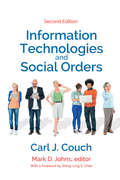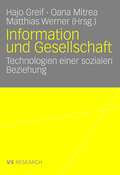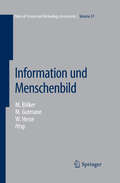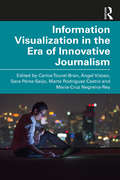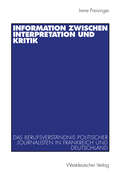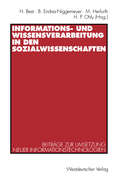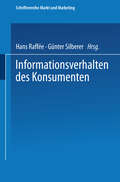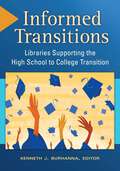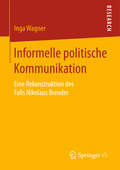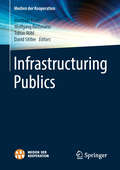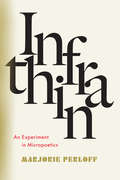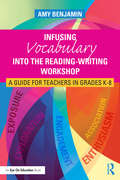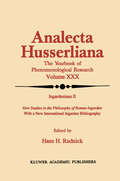- Table View
- List View
Information Technologies and Social Orders (Communication And Social Order Ser.)
by Carl J. CouchAccording to Carl J. Couch, the history of human society is one of successive, sometimes overlapping, information technologies used to process the various symbolic representations that inform social contexts. Unlike earlier “media” theorists who ignored social context in order to concentrate on the information technologies themselves, Couch implements a consistent theory of interpersonal and intergroup relations to describe the essential interface between information technologies and the social contexts in which they are used. Couch emphasizes the formative capacities of information technologies across historical epochs and cultures, and places them within the major institutional relations of various societies. He views social orders as reflexively shaped by the information technologies that participants use, and as susceptible to mass brutality and oppression due to oligarchic control though he hopes technology will remain humane. The original edition of this manuscript was nearly complete at the time of Couch’s death and was brought to completion by two of his closest associates. Now after two decades, during which its impact is indisputable, it has been updated for a new generation of students and scholars. Additions include discussions on books in the digital age, social media, mobile telephones, recordings, participatory culture, and more.
Information Technology in Languages for Specific Purposes: Issues and Prospects (Educational Linguistics #7)
by Antonia Soler Cervera Carmen Rueda Ramos Elisabet Arnó MaciàI first used the Internet in fall 1993, as a Fulbright Scholar at Charles University in Prague. I immediately recognized that the Internet would radically transform second language teaching and learning, and within a year had written my first book on the topic, E-Mail for English Teaching. The book galvanized a wave of growing interest in the relationship of the Internet to language learning, and was soon followed by many more books on the topic by applied linguists or educators. This volume, though, represents one of the first that specifically analyzes the relationship of new technologies to the teaching of languages for specific purposes (LSP), and, in doing so, makes an important contribution. The overall impact of information and communication technology (ICT) on second language learning can be summarized in two ways, both of which have special significance for teaching LSP. First, ICT has transformed the context of language learning. The stunning growth of the Internet—resulting in 24 trillion email messages sent in 2005, and more than 600 billion Web pages and 50 million blogs online in the same year—has helped make possible the development of English as the world's first global language.
Information und Gesellschaft: Technologien einer sozialen Beziehung
by Hajo Greif Oana Mitrea Matthias WernerInformations- und Kommunikationstechnologien sind nicht nur ein fester Bestandteil der täglichen Lebens- und Arbeitswelt, sondern strukturieren auch den Weltzugang gesellschaftlicher Akteure. Der Band versammelt Beiträge aus den Technik- und Sozialwissenschaften zur Beziehung zwischen Information und Gesellschaft.
Information und Menschenbild (Ethics of Science and Technology Assessment #37)
by Michael Bölker Mathias Gutmann Wolfgang HesseBegriffe wie „Information" oder „Gen" beeinflussen den Wandel von Menschenbildern in Wissenschaft und Gesellschaft. Um zu einem angemessenen Verständnis vom Menschen zu gelangen, müssen die in die Forschung eingebrachten anthropologischen Prämissen kritisch analysiert werden. Der Band dokumentiert die Beiträge von Wissenschaftlern aus den Bereichen Informatik, Biologie und Philosophie zu einer Tagung, die sich mit der Bedeutung von Begriffen befasste, die vor allem in der neuesten biologisch-genetischen Forschung verwendet werden.
Information Visualization in The Era of Innovative Journalism
by Carlos Toural-BranInformation Visualization in the Era of Innovative Journalism brings together over 30 authors from countries around the world to synthesize how recent technological innovations have impacted the development, practice and consumption of contemporary journalism. As technology rapidly progresses, shifts, and innovates, there have been immense changes in the way we communicate. This book collects research from around the world that takes an in-depth look at the primary transformations related to journalistic innovation in recent times. High-profile contributors provide cutting-edge scholarship on innovation in journalism as it relates to emergent topics such as virtual reality, podcasting, multimedia infographics, social media, mobile storytelling and others. The book pays special attention to the development of information visualization and the ability of recent innovations to meet audience needs and desires. Students and scholars studying contemporary journalism history and practice will find this a vital and up-to-date resource, as well as those studying communication technology as it relates to marketing, PR or mass media broadly.
Information Visualization in The Era of Innovative Journalism
by Carlos Toural-Bran Ángel Vizoso Sara Pérez-Seijo Marta Rodríguez-Castro María-Cruz Negreira-ReyInformation Visualization in the Era of Innovative Journalism brings together over 30 authors from countries around the world to synthesize how recent technological innovations have impacted the development, practice and consumption of contemporary journalism. As technology rapidly progresses, shifts, and innovates, there have been immense changes in the way we communicate. This book collects research from around the world that takes an in-depth look at the primary transformations related to journalistic innovation in recent times. High-profile contributors provide cutting-edge scholarship on innovation in journalism as it relates to emergent topics such as virtual reality, podcasting, multimedia infographics, social media, mobile storytelling and others. The book pays special attention to the development of information visualization and the ability of recent innovations to meet audience needs and desires. Students and scholars studying contemporary journalism history and practice will find this a vital and up-to-date resource, as well as those studying communication technology as it relates to marketing, PR or mass media broadly.
Information zwischen Interpretation und Kritik: Das Berufsverständnis politischer Journalisten in Frankreich und Deutschland
by Irene PreisingerDer Vergleich zwischen Frankreich und Deutschland zeigt, dass in demokratischen Systemen politischer Journalismus unterschiedlich geregelt sein kann. Als Basisleistung der Information gilt links wie rechts des Rheins der Austausch zwischen politischer Führung und Öffentlichkeit. Aber mehr als 100 Interviews verdeutlichen, dass Redakteure meinungsführender Printmedien der beiden Länder dabei verschiedene Aspekte betonen. Beispielsweise nähern sich die einen dem angelsächsischen Modell des Journalismus, während die anderen sich wegorientieren. Auch der Fokus ist länderspezifisch: Information oszilliert zwischen Interpretation und Kritik.
The Informational Complexity of Learning: Perspectives on Neural Networks and Generative Grammar
by Partha NiyogiAmong other topics, The Informational Complexity of Learning: Perspectives on Neural Networks and Generative Grammar brings together two important but very different learning problems within the same analytical framework. The first concerns the problem of learning functional mappings using neural networks, followed by learning natural language grammars in the principles and parameters tradition of Chomsky. These two learning problems are seemingly very different. Neural networks are real-valued, infinite-dimensional, continuous mappings. On the other hand, grammars are boolean-valued, finite-dimensional, discrete (symbolic) mappings. Furthermore the research communities that work in the two areas almost never overlap. The book's objective is to bridge this gap. It uses the formal techniques developed in statistical learning theory and theoretical computer science over the last decade to analyze both kinds of learning problems. By asking the same question - how much information does it take to learn? - of both problems, it highlights their similarities and differences. Specific results include model selection in neural networks, active learning, language learning and evolutionary models of language change. The Informational Complexity of Learning: Perspectives on Neural Networks and Generative Grammar is a very interdisciplinary work. Anyone interested in the interaction of computer science and cognitive science should enjoy the book. Researchers in artificial intelligence, neural networks, linguistics, theoretical computer science, and statistics will find it particularly relevant.
Informations- und Wissensverarbeitung in den Sozialwissenschaften: Beiträge zur Umsetzung neuer Informationstechnologien
by Heinrich Best Brigitte Endres-Niggemeyer Matthias Herfurth H. Peter OhlyDie Beiträge behandeln aus verschiedenen Blickwinkeln einen durch die Begriffe Sozialwissenschaft-Informatik-Information abgegrenzten, interdisziplinären Themenkomplex. Gerade in den Sozialwissenschaften haben die qualitative Textinterpretation und die Suche nach typischen, einzelnen Fällen ihren festen Stellenwert, und automatische Informationssuche und Informationsaufbereitung sind zu unverzichtbaren Forschungsinstrumenten geworden. Dieser Band enthält eine Vielzahl von Fachbeiträgen, die im Rahmen entsprechender Spezialveranstaltungen entstanden sind oder eigens für diesen Band geschrieben wurden. Sowohl als Einführungen wie auch im Rahmen spezieller Fragestellungen werden Ansätze aus den Gebieten künstliche Intelligenz, Bilderkennung, Kommunikationsnetze, Hypertext, Szientometrie, Bibliometrie u. a., jeweils mit Bezug auf sozialwissenschaftliche Anwendung, vorgestellt.
Informationserschließung und Automatisches Indexieren: Ein Lehr- und Arbeitsbuch (X.media.press)
by Winfried Gödert Klaus Lepsky Matthias NagelschmidtKenntnisse der Modellierung dokumentenbezogener Metadaten vermitteln die Autoren in dem Band vor allem durch praxisnahe Aufgabenstellungen – begleitet von theoretischen Erläuterungen und ergänzenden Übungen. Leser lernen, wie Datenbanken aufgebaut und mit Suchumgebungen ausgestattet werden. Dabei dienen Bilddokumente und bibliografische Daten als Beispiele. Ihre inhaltliche Erschließung wird insbesondere anhand der semantischen Strukturierung und des automatischen Indexierens erläutert. Die begleitende Webseite bietet zusätzliche Arbeitsmaterialien.
Informationsverhalten des Konsumenten: Ergebnisse empirischer Studien (Schriftenreihe Markt und Marketing)
Informationsvermittlung im Zeitalter der Unterhaltung: Eine Langzeitanalyse politischer Fernsehmagazine (Studien zur Kommunikationswissenschaft #47)
by Claudia WegenerPolitische Magazine sind seit Jahrzehnten fester Bestandteil des deutschen Fernsehprogramms. In dem vorliegenden Buch wird die Frage aufgegriffen, ob und wie sich Selektion und Inszenierung von Information in etablierten politischen Magazinen öffentlich-rechtlicher Sendeanstalten seit der Einführung des dualen Rundfunksystems verändert haben. Darüber hinaus werden konvergente Entwicklungen hinsichtlich öffentlich-rechtlicher und privat-kommerzieller Magazine analysiert. Dass eine unterhaltsame Berichterstattung keineswegs mit einer Trivialisierung der Inhalte einhergehen muss, kann die Autorin am Beispiel öffentlich-rechtlicher Polit-Magazine belegen.
Informed Transitions: Libraries Supporting the High School to College Transition
by Kenneth J. BurhannaHow can libraries and librarians across the educational continuum work together to support student transitions from high school to college, utilizing free or low-cost resources? This book supplies the answers.Informed Transitions: Libraries Supporting the High School to College Transition identifies the ways in which libraries and librarians can work together and create valuable resources that help students transition successfully to college—despite the challenges of increasing demand and diminishing resources.The book is organized into three sections: background, expectations, and skills; conversations and collaborations; and programs and resources. Section 1 establishes a foundational understanding of the libraries' role in supporting college transitions. Section 2 shares model conversations that move this work forward, stressing its collaborative nature. The third section highlights some well-established programs and resources that effectively support high school to college transitions. Practical information is provided throughout, pinpointing what high school students need to know to smoothly transition to college, spotlighting the expectations of college professors, and discussing audience-specific methods of working with students at the high school and college levels.
Informed Transitions: Libraries Supporting the High School to College Transition
by Kenneth J. Burhanna Toni Anaya Leslie Barton Kathleen Conley Paula Nespeca Deal Leanne Ellis Robert Farrell Anthony J. Fonseca Mitchell J. Fontenot Kim Garwood Julie A. Gedeon Matthew Harrick Laurie Hathman Rhonda Huisman Curtis L. Kendrick JaNae Kinikin Dale Lackeyram Jillian Brandt Maruskin Clarke Mathany Charlene Maxey-Harris Louis E. Mays Brian L. Mikesell Megan Oakleaf Kindra Orr Patricia L. Owen Anne Marie Perrault Peggy A. Pritchard Thomas L. Reinsfelder Debra Cox Rollins Sherri Savage Barbara F. Schloman Kathryn B. Seidel Jennifer Sigalet Ann Walker Smalley Ann Marie Smeraldi Ken W. Stewart Barbara K. Stripling LeAnn Suchy Teresa Tartaglione Jill E. Thompson Tammy J. Eschedor Voelker Meghann Suzanne Walk Kate ZoellnerHow can libraries and librarians across the educational continuum work together to support student transitions from high school to college, utilizing free or low-cost resources? This book supplies the answers.Informed Transitions: Libraries Supporting the High School to College Transition identifies the ways in which libraries and librarians can work together and create valuable resources that help students transition successfully to college—despite the challenges of increasing demand and diminishing resources.The book is organized into three sections: background, expectations, and skills; conversations and collaborations; and programs and resources. Section 1 establishes a foundational understanding of the libraries' role in supporting college transitions. Section 2 shares model conversations that move this work forward, stressing its collaborative nature. The third section highlights some well-established programs and resources that effectively support high school to college transitions. Practical information is provided throughout, pinpointing what high school students need to know to smoothly transition to college, spotlighting the expectations of college professors, and discussing audience-specific methods of working with students at the high school and college levels.
Informelle politische Kommunikation: Eine Rekonstruktion des Falls Nikolaus Brender
by Inga WagnerWelche Konsequenzen politischer Einfluss in einem öffentlich-rechtlichen Sender haben kann, zeigt Inga Wagner am Fall Nikolaus Brender, dessen Vertrag als ZDF-Chefredakteur aufgrund einer politischen Entscheidung im Verwaltungsrat nicht verlängert wurde. Anhand von Interviews mit den unmittelbar Beteiligten rekonstruiert die Autorin den informellen Entscheidungsprozess, der neben der öffentlichen Inszenierung ablief, um die Frage zu beantworten, wie es zu der Entscheidung im Fall Nikolaus Brender kam. Das Ringen des Intendanten mit den konträren Positionen der SPD- und unionsnahen Verwaltungsräte, angeführt von den politischen Schwergewichten Kurt Beck und Roland Koch, blieb lange eine interne Personalangelegenheit – bis sie an die Öffentlichkeit drang und schließlich ein Fall für das Bundesverfassungsgericht wurde.
Infoselves: The Value of Online Identity
by Demetra GarbasevschiInfoselves delivers a multifaceted analysis of the commodification of self-identity online, from both a domination and a liberation perspective. Drawing on multiple resources, the book places its discussion of online identity within the larger context of self-identity evolution, arguing for the recognition of online identity as a legitimate component of the self-identity system. Advertising executive turned academic, Demetra Garbașevschi offers readers the means to understand the way our online identities are formed and used, to reflect on the future of self-identity, and to become more aware of the radical implications of our digital footprint. Readers will discover what it means to be an infoself in a deep digital context, from exploring the informational makeup of self-identity, to examining the various sources of identity information found online, to exposing the uses of this information through both latent and assertive self-commodification. Considering the many sources of information contributing to our identity narrative online, some beyond our direct control, managing the self is presented as one the greatest challenges of our digital present. The book includes illuminating discussions of a variety of topics within the subject of online identity, such as: Foundational concepts related to the idea of identity, including references to the works of Erik Erikson, symbolic interactionists, and social dramaturgy The evolution of online identity, with examinations of early and current viewpoints of the phenomenon Personal branding online as the epitome of self-commodification, with examples from online celebrity, micro-celebrity, and nano-celebrity Original research contributing to the larger discussion about how identities are constructed and performed through-the-line Perfect for graduate students in advertising, branding, and public relations, Infoselves also belongs on the bookshelves of those studying fields involving digital media. Working professionals in any of these areas will also benefit from this book’s insightful analyses of a variety of viewpoints on online identity.
Infoselves: The Value of Online Identity
by Demetra GarbasevschiInfoselves delivers a multifaceted analysis of the commodification of self-identity online, from both a domination and a liberation perspective. Drawing on multiple resources, the book places its discussion of online identity within the larger context of self-identity evolution, arguing for the recognition of online identity as a legitimate component of the self-identity system. Advertising executive turned academic, Demetra Garbașevschi offers readers the means to understand the way our online identities are formed and used, to reflect on the future of self-identity, and to become more aware of the radical implications of our digital footprint. Readers will discover what it means to be an infoself in a deep digital context, from exploring the informational makeup of self-identity, to examining the various sources of identity information found online, to exposing the uses of this information through both latent and assertive self-commodification. Considering the many sources of information contributing to our identity narrative online, some beyond our direct control, managing the self is presented as one the greatest challenges of our digital present. The book includes illuminating discussions of a variety of topics within the subject of online identity, such as: Foundational concepts related to the idea of identity, including references to the works of Erik Erikson, symbolic interactionists, and social dramaturgy The evolution of online identity, with examinations of early and current viewpoints of the phenomenon Personal branding online as the epitome of self-commodification, with examples from online celebrity, micro-celebrity, and nano-celebrity Original research contributing to the larger discussion about how identities are constructed and performed through-the-line Perfect for graduate students in advertising, branding, and public relations, Infoselves also belongs on the bookshelves of those studying fields involving digital media. Working professionals in any of these areas will also benefit from this book’s insightful analyses of a variety of viewpoints on online identity.
Infrastructuring Publics (Medien der Kooperation)
by Matthias Korn Wolfgang Reißmann Tobias Röhl David SittlerThe volume scrutinizes publics and infrastructures not separately but in their constitutive interrelations and resonances. The contributions, originating in a range of disciplinary perspectives, share a praxeological approach, discussing historical and current processes of mediated cooperation in infrastructuring and making public(s) by tracing different forms of the production, design, and historic trajectories of various publics and infrastructures.
Infrathin: An Experiment in Micropoetics
by Marjorie PerloffEsteemed literary critic Marjorie Perloff reconsiders the nature of the poetic, examining its visual, grammatical, and sound components. The “infrathin” was Marcel Duchamp’s playful name for the most minute shade of difference: that between the report of a gunshot and the appearance of the bullet hole, or between two objects in a series made from the same mold. “Eat” is not the same thing as “ate.” The poetic, Marjorie Perloff suggests, can best be understood as the language of infrathin. For in poetry, whether in verse or prose, words and phrases that are seemingly unrelated in ordinary discourse are realigned by means of sound, visual layout, etymology, grammar, and construction so as to “make it new.” In her revisionist “micropoetics,” Perloff draws primarily on major modernist poets from Stein and Yeats to Beckett, suggesting that the usual emphasis on what this or that poem is “about,” does not do justice to its infrathin possibilities. From Goethe’s eight-line “Wanderer’s Night Song” to Eliot’s Four Quartets, to the minimalist lyric of Rae Armantrout, Infrathin is designed to challenge our current habits of reading and to answer the central question: what is it that makes poetry poetry?
Infrathin: An Experiment in Micropoetics
by Marjorie PerloffEsteemed literary critic Marjorie Perloff reconsiders the nature of the poetic, examining its visual, grammatical, and sound components. The “infrathin” was Marcel Duchamp’s playful name for the most minute shade of difference: that between the report of a gunshot and the appearance of the bullet hole, or between two objects in a series made from the same mold. “Eat” is not the same thing as “ate.” The poetic, Marjorie Perloff suggests, can best be understood as the language of infrathin. For in poetry, whether in verse or prose, words and phrases that are seemingly unrelated in ordinary discourse are realigned by means of sound, visual layout, etymology, grammar, and construction so as to “make it new.” In her revisionist “micropoetics,” Perloff draws primarily on major modernist poets from Stein and Yeats to Beckett, suggesting that the usual emphasis on what this or that poem is “about,” does not do justice to its infrathin possibilities. From Goethe’s eight-line “Wanderer’s Night Song” to Eliot’s Four Quartets, to the minimalist lyric of Rae Armantrout, Infrathin is designed to challenge our current habits of reading and to answer the central question: what is it that makes poetry poetry?
Infusing IB Philosophy and Pedagogy into Chinese Language Teaching
by Mark S. ShumThis book not only examines what IB philosophy is, it also explores the relationship between IB philosophy and Chinese language and culture and introduces a lot of useful and creative teaching pedagogies and methodologies. Most importantly, this book fills the gap of implementing IB philosophy and pedagogy into Chinese language teaching.
Infusing Vocabulary Into the Reading-Writing Workshop: A Guide for Teachers in Grades K-8
by Amy BenjaminLearn how to make vocabulary instruction more effective by making better use of mini-lessons and word study time to achieve durable learning about words and how they work. In this essential new book, literacy expert Amy Benjamin presents her 4E model (Exposure, Exploration, Engagement, Energy) for teaching vocabulary so that students gain deep understanding, improving their overall language and literacy skills. Benjamin guides you through bringing these 4Es to life in your K-8 reading-writing workshop. -Exposure: Enrich your teacher talk with sophisticated words and phrases to facilitate natural language acquisition and application of new words. -Exploration: Promote consistent vocabulary growth with a multifaceted instructional approach that incorporates etymology, word associations, word families, spelling, and morphology. -Engagement: Build students’ confidence by encouraging meaningful use of new words, both in and out of the classroom. -Energy: Enliven your workshop and increase participation with a variety of word games, puzzles, projects, and cooperative learning activities. Each chapter provides practical examples and scenarios to help you apply the model to your own classroom. The appendices include a variety of strategies for organizing reading-writing workshops, a thorough introduction to academic word lists and their role in vocabulary instruction, and an analysis of forty Latin and Greek word roots for mini-lessons.
Infusing Vocabulary Into the Reading-Writing Workshop: A Guide for Teachers in Grades K-8
by Amy BenjaminLearn how to make vocabulary instruction more effective by making better use of mini-lessons and word study time to achieve durable learning about words and how they work. In this essential new book, literacy expert Amy Benjamin presents her 4E model (Exposure, Exploration, Engagement, Energy) for teaching vocabulary so that students gain deep understanding, improving their overall language and literacy skills. Benjamin guides you through bringing these 4Es to life in your K-8 reading-writing workshop. -Exposure: Enrich your teacher talk with sophisticated words and phrases to facilitate natural language acquisition and application of new words. -Exploration: Promote consistent vocabulary growth with a multifaceted instructional approach that incorporates etymology, word associations, word families, spelling, and morphology. -Engagement: Build students’ confidence by encouraging meaningful use of new words, both in and out of the classroom. -Energy: Enliven your workshop and increase participation with a variety of word games, puzzles, projects, and cooperative learning activities. Each chapter provides practical examples and scenarios to help you apply the model to your own classroom. The appendices include a variety of strategies for organizing reading-writing workshops, a thorough introduction to academic word lists and their role in vocabulary instruction, and an analysis of forty Latin and Greek word roots for mini-lessons.
Ingardeniana II: New Studies in the Philosophy of Roman Ingarden With a New International Ingarden Bibliography (Analecta Husserliana #30)
by Hans H. RudnickThis Ingardenia volume is the second in the Analecta Husserliana series that is entirely devoted to the phenomenology of Roman Ingarden. The first was volume IV (1976). Twenty years after Ingarden's death, this volume demonstrates that the Polish phenomenologist's contribution to philosophy and literary scholarship has received world-wide attention. His ideas have proven especially fruitful for the definition of the structure of the literary work of art and the subsequent recognition of its characteristic features. Of all the early phenomenologists who were students of Husserl, it is Ingarden whose work has faithfully pursued the original tenet that language "holds" the essence of the life-world "in readiness" (bereit halten). To investigate this premise with the rigor of a science, as Husserl had envisioned for phenomenology, was Ingarden's life work. That Ingarden did not quite reach his ambitious goal does not diminish his unquestionable achievement. The understanding of the nature of the literary work of art has increased enormously because of his analyses and aesthetics. The Polish phenomenologist investigated above all the work of art as a structure of necessary components which define and determine its nature. That the artistic ingredient was shortchanged under those conditions should not be surprising, particu larly since Ingarden usually kept a purist's philosophical distance from the concrete detail of the material under consideration. He was not concerned with individual works of art but with the principle that was shared by all of them as the defining feature of their being.
